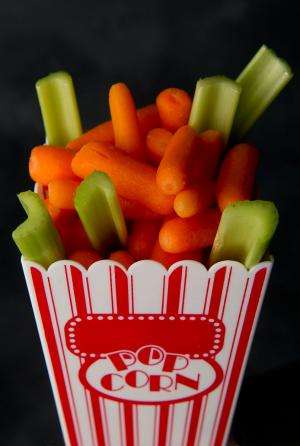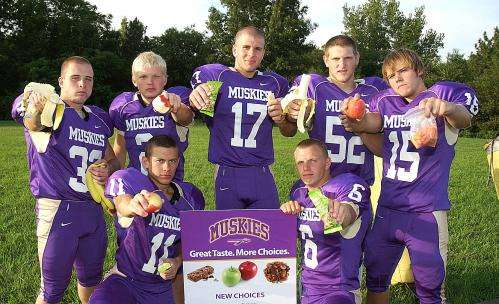Healthy food is good for you—and can sell, too

In the fall of 2008, the booster club in Muscatine, Iowa took a chance. Researchers from the University of Iowa asked whether the club would add healthy foods – from apples to string cheese – to its concessions menu. And, by the way, would it also consider putting healthier ingredients in big sellers like nachos and popcorn?
These were no idle requests. Booster clubs across the United States directly support schools' athletic and extra-curricular programs like band and choir. The Muskie Boosters, for instance, raise $90,000 annually for athletics and other outside school activities. With crucial dollars at stake, clubs can be reluctant to tinker with a reliable cash generator like concession sales.
"I don't think without [revenue from] booster clubs, especially with how schools are cutting things, how they'd be able to do it," says Kate Hansen a former president of the Muskie Boosters.
The little gamble paid off for the Muskies. According to a new study published this week in the Journal of Public Health, the club netted stable sales and revenues with the healthy-food additions over one full season. Profits remained intact as well. Average sales per varsity football game rose to $6,849 in 2009 from $6,599 the year before, an increase of 4 percent. Moreover, the healthy foods made up 9.2 percent of concession sales, signaling the new products could boost overall sales. Parents and students also said they were happy with the healthy-food choices, according to surveys cited in the study.
"This study is the first to evaluate the results on satisfaction and sales of making changes to concession-stand offerings in school settings," writes the research team, led by Helena Laroche, assistant professor in internal medicine and pediatrics at the UI and the study's corresponding author. "It provides preliminary evidence that altering offerings and adding healthy options can be done by working in concert with parent groups. Furthermore, these modifications can provide reasonable revenue and profit margins without negative effects on customer satisfaction."

To date, six other school booster clubs in Iowa have added healthy foods to their concession menus, following a how-to guide written by Laroche based on her experience in Muscatine.
"Booster groups have worried that healthier items wouldn't sell, and it's important for them to make money to support student activities," Larochesays. "This shows it can be done."
The Muskie Boosters offered eight healthy foods: Apples, carrots and dip, chicken sandwiches, granola bars, pickles, soft pretzels, string cheese and trail mix. The items were sold durning the 2009 fall season at Muscatine High football games, volleyball matches and swim meets. Additionally, boosters substituted canola oil for coconut oil bars in the popcorn, and swapped the cheese in the nachos, eliminating trans fat from the products. The group advertised the new offerings in a poster and marketing campaign with the slogan, "Great taste, more variety."
While all the healthy foods sold, chicken sandwiches and pretzels dominated, accounting for 7.6 percent of all food sales, sales data showed. Sales of other items varied according to weather, venue and product visibility. Granola bars and trail mix sold better indoors, while carrots and dip were popular in benign, outdoor weather. String cheese suffered from being tucked away in a refrigerator. Pickles were especially popular with students. And, no one noticed the healthier changes to the popcorn and nachos, which continued to sell briskly.
Researchers from Cornell University's Food and Brand Lab analyzed the sales data.
"If you're a concession-stand sponsor, and you want people to eat better, and you want to make more money, add at least five healthy items," says Brian Wansink, the Cornell lab's director and a marketing professor. "There's got to be a critical mass, and we find that five's a very lucky number, and ten is even better."
To be sure, classic concession items – hot dogs, pizza and candy bars – continued to sell well. But Hansen says she noticed a shift in people's perception and attitudes about the new offerings.
"I think what it comes down to is people want to have choices," says Hansen, who was the Muscatine booster club president during the study. "We still sell hot dogs, we still sell pizza, we still sell candy bars. But everything in life is about choices, and it's important to put choices out there that meets everybody's needs and wants, and more people, it seems, want to lead healthier lives."


















